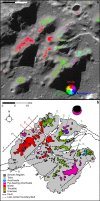Peak-ring structure and kinematics from a multi-disciplinary study of the Schrödinger impact basin
- PMID: 27762265
- PMCID: PMC5080443
- DOI: 10.1038/ncomms13161
Peak-ring structure and kinematics from a multi-disciplinary study of the Schrödinger impact basin
Abstract
The Schrödinger basin on the lunar farside is ∼320 km in diameter and the best-preserved peak-ring basin of its size in the Earth-Moon system. Here we present spectral and photogeologic analyses of data from the Moon Mineralogy Mapper instrument on the Chandrayaan-1 spacecraft and the Lunar Reconnaissance Orbiter Camera (LROC) on the LRO spacecraft, which indicates the peak ring is composed of anorthositic, noritic and troctolitic lithologies that were juxtaposed by several cross-cutting faults during peak-ring formation. Hydrocode simulations indicate the lithologies were uplifted from depths up to 30 km, representing the crust of the lunar farside. Through combining geological and remote-sensing observations with numerical modelling, we show that a Displaced Structural Uplift model is best for peak rings, including that in the K-T Chicxulub impact crater on Earth. These results may help guide sample selection in lunar sample return missions that are being studied for the multi-agency International Space Exploration Coordination Group.
Figures








References
-
- Ohtake M. et al.. The global distribution of pure anorthosite on the Moon. Nature 461, 236–240 (2009). - PubMed
-
- Yamamoto S. et al.. Olivine-rich exposures in the South Pole-Aitken Basin. Icarus 218, 331–344 (2012).
-
- Kramer G. Y., Kring D. A., Nahm A. L. & Pieters C. M. Spectral and photogeologic mapping of Schrödinger Basin and implications for the post-South Pole-Aitken impact deep subsurface stratigraphy. Icarus 223, 131–148 (2013).
-
- Potter R. W. K., Collins G. S., Kiefer W. S., McGovern P. J. & Kring D. A. Constraining the size of the South Pole-Aitken basin impact. Icarus 220, 730–743 (2012).
-
- Ohtake M. et al.. Geologic structures generated by large-impact basin formation observed at the South Pole-Aitken basin on the Moon. Geophys. Res. Lett. 41, 2738–2745 (2014).
Publication types
LinkOut - more resources
Full Text Sources
Other Literature Sources

